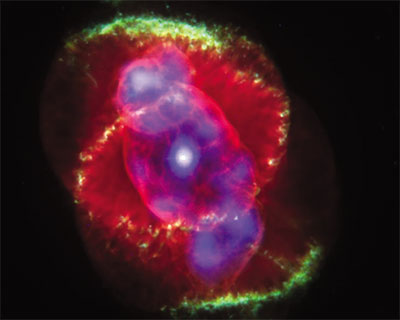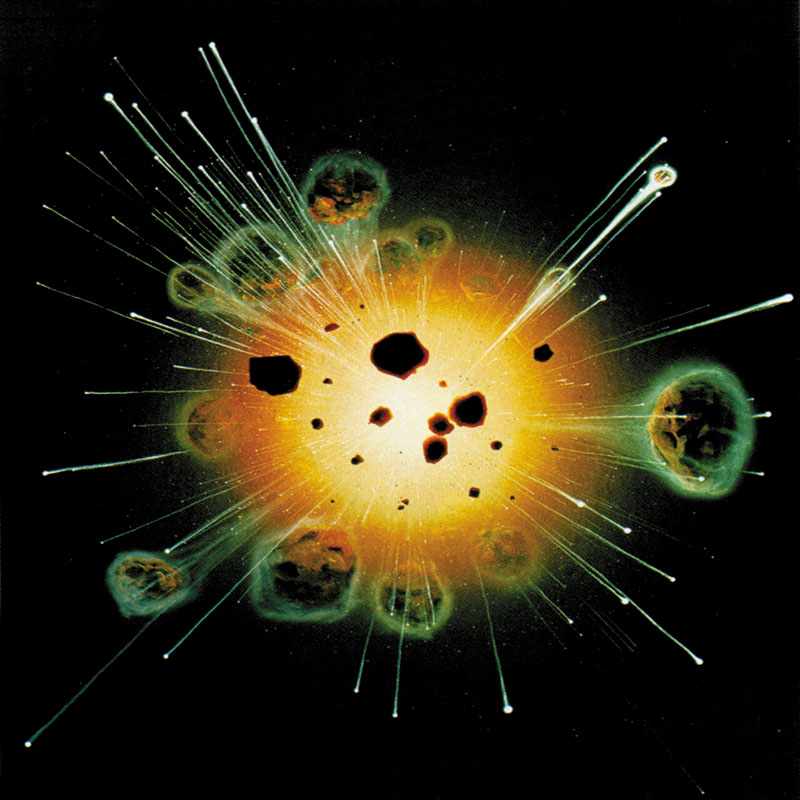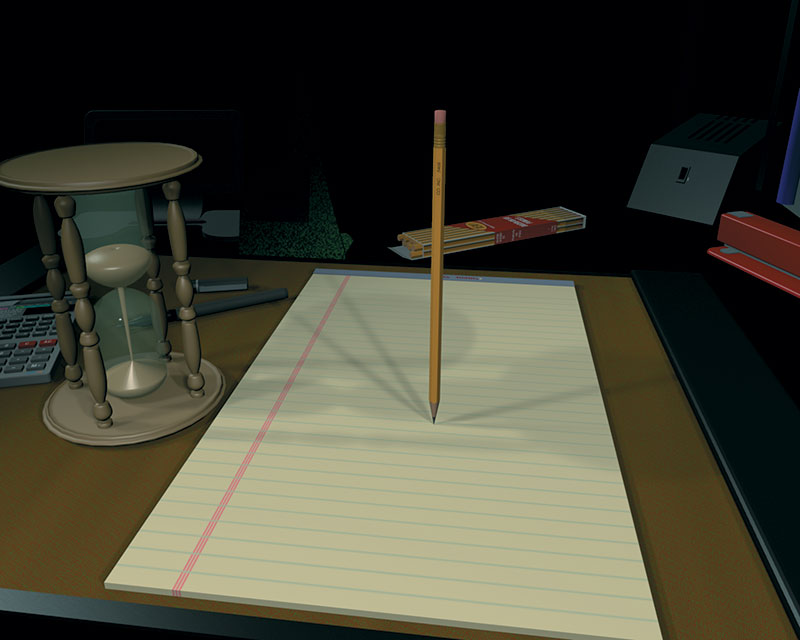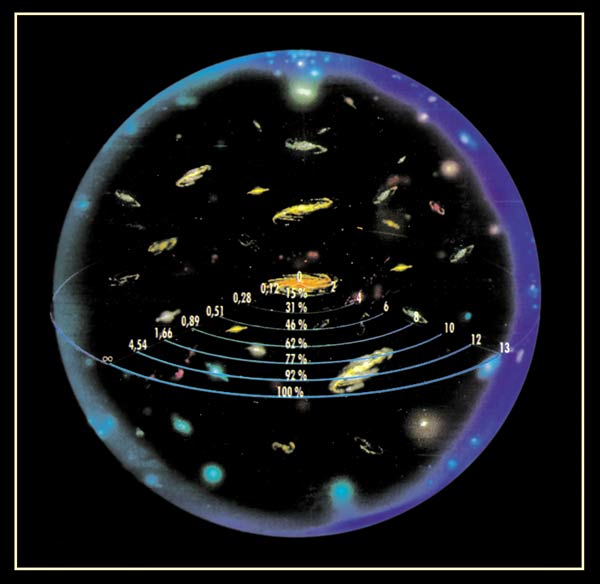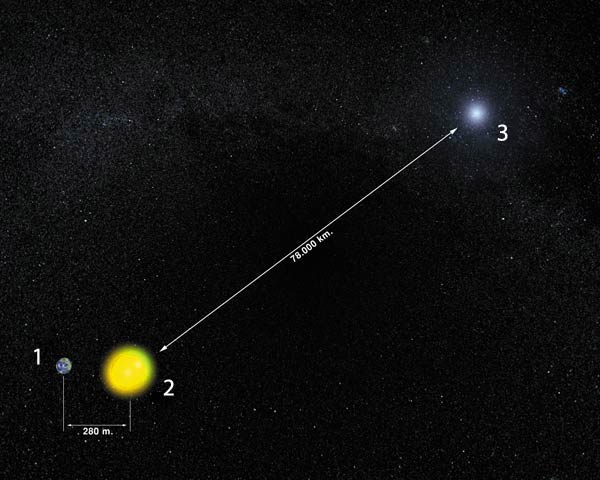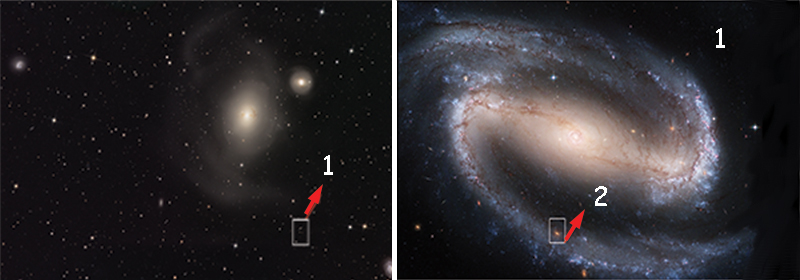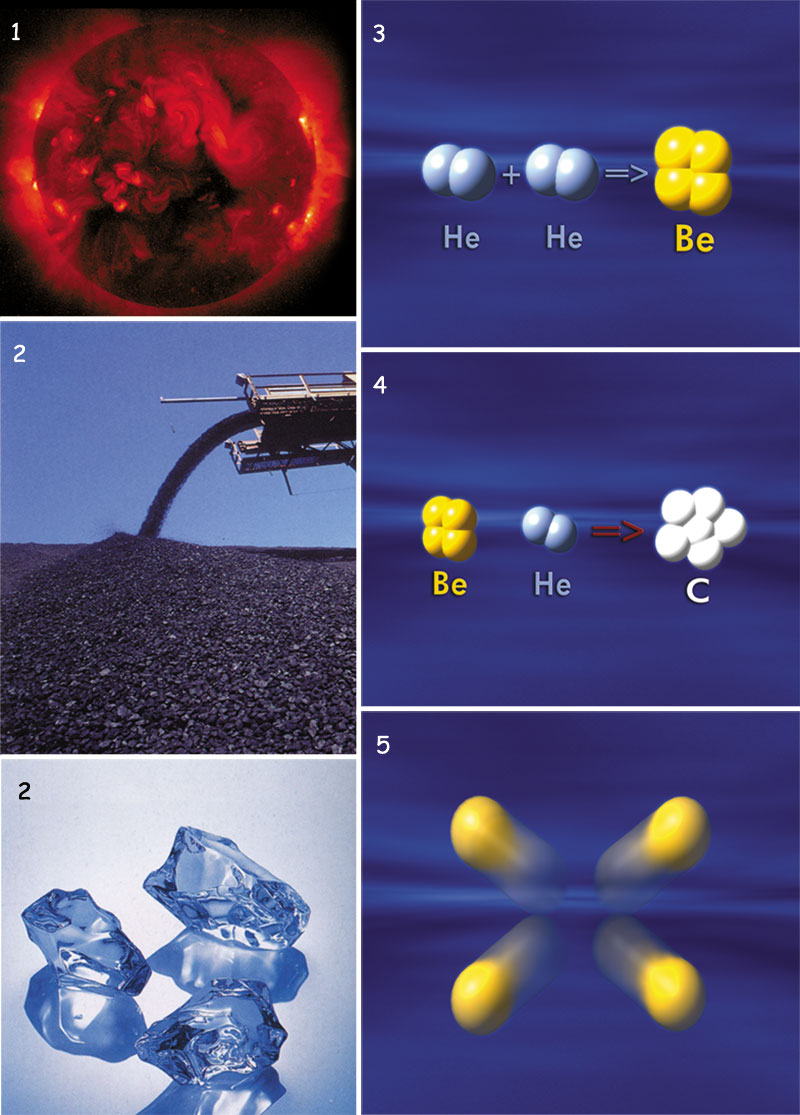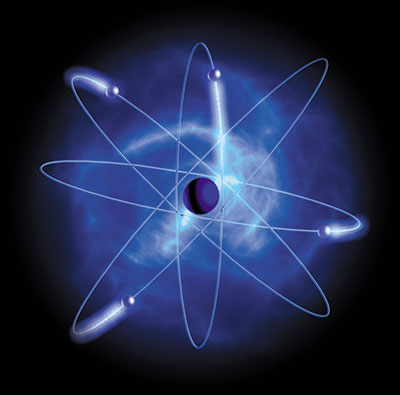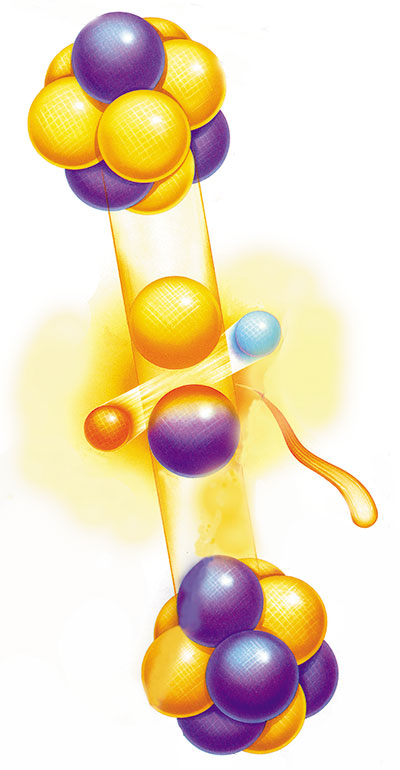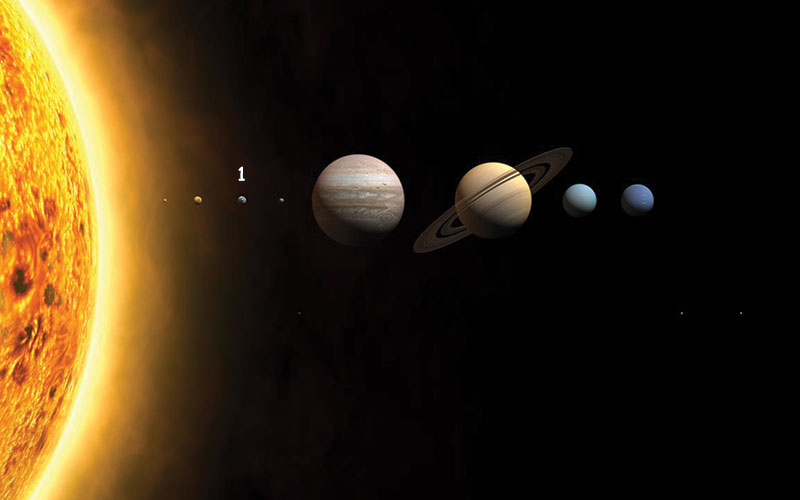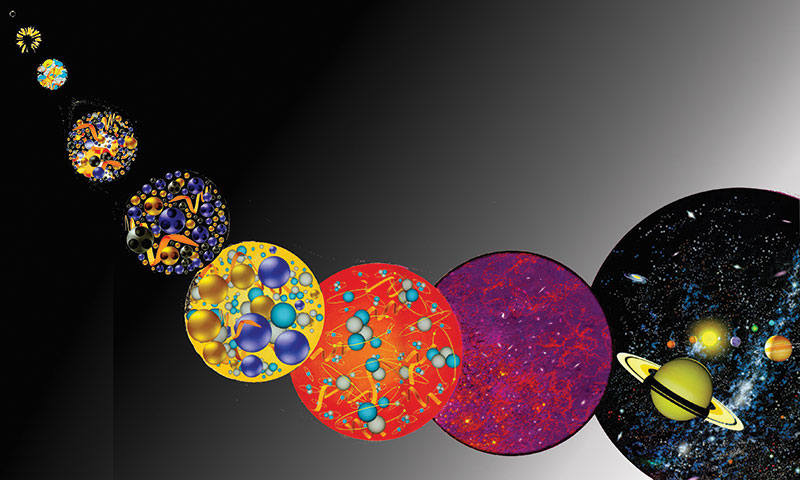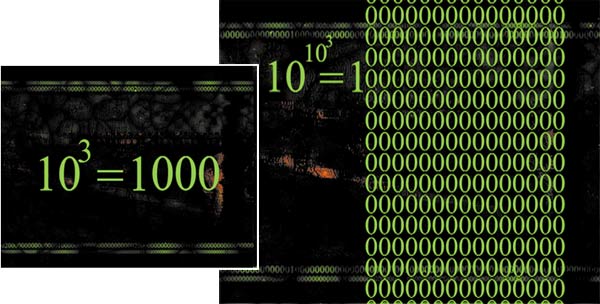Bigotry: The Dark Danger
A Chain of Miracles

DOWNLOAD THE BOOK
CHAPTERS OF THE BOOK
< <
2 / total: 5
Chapter 1: Miracles in The Creation of The UniverseThe Incredible Order That Came With The Explosion
The whole scientific community acknowledges that the universe we live in began approximately 15 billion years ago with a huge explosion popularly called "the Big Bang" and expanded to take on its present state and dimensions. Space, galaxies, planets, the Sun, the Earth—in short, everything that combines to make up the universe was formed as a consequence. Here lies a great secret: Since the Big Bang was an explosion, matter would be expected to have scattered itself randomly across space, as atoms or sub-atomic particles. But not so; on the contrary, the universe in all its incredible order emerged instead. "Randomly" scattered atoms concentrated in certain places and bonded to form stars, solar systems and galaxies—certainly an extraordinary situation. And to use an analogy used by scientist, even more extraordinary than a hand grenade thrown into a wheat field with the result that the effect of the blast collects the cut wheat, ties it into uniform bales, and piles up the bales in an orderly fashion. Professor Fred Hoyle, who opposed the Big Bang theory for many years, expressed his wonder as follows: The big bang theory holds that the universe began with a single explosion. Yet, ... an explosion merely throws matter apart, while the big bang has mysteriously produced the opposite effect— with matter clumping together in the form of galaxies. .5 Obviously, such an explosion that contained the whole of the universe’s mass, from which the most spectacular order emerged, can only be explained by a miracle. Astrophysicist Alan Sandage, winner of the Crawford prize in astronomy, explains the situation as follows:
I find it quite improbable that such order came out of chaos. There has to be some organizing principle. God to me is a mystery but is the explanation for the miracle of existence… 6 As scientists state, it is a fantastic miracle that atoms should bond in the most appropriate ways to create the infinitely coordinated order of the universe, comprising countless trillions of planets, billions of stars in billions of galaxies, and all without the slightest hitch. This is a miracle shown to us by the infinitely powerful God. He to Whom the kingdom of the heavens and the Earth belongs. He does not have a son and He has no partner in the Kingdom. He created everything and determined it most exactly. (Qur’an, 25:2)
A Miracle In The Universe's Expansion RateThe universe’s expansion is critical to the formation of its present state. Had it been a fraction slower, the whole of the universe would have contracted once again and collapsed on itself, before the fledgling solar systems had any chance to develop. Had its rate of expansion been only a fraction faster, matter would have been dispersed irretrievably in the vastness of space, unable to form neither stars nor galaxies. Either situation would mean that living things, let alone we humans, could not exist. However, neither scenario happened. Thanks to the actual rate of expansion, the universe as we know it emerged. But how sensitive is this rate, actually? Paul Davies, a renowned Professor of Mathematics and Physics at Australia’s Adelaide University, made a series of calculations in order to answer this question. The results he obtained were astonishing. According to Davies, had the expansion rate following the Big Bang been different by one in a billion billions (1/1018)), the universe could not have formed! Another way of stating this figure is: "0,000000000000000001". Any divergence of such a tiny scale would have meant no universe at all. Davies interprets this result as follows: Careful measurements put the rate of expansion very close to a critical value at which the universe will just escape its own gravity and expand forever. A little slower and the cosmos would collapse, a little faster and the cosmic material would have long ago completely dispersed. It is interesting to ask precisely how delicately the rate of expansion has been "fine tuned" to fall on this narrow dividing line between two catastrophes. If at time I S (by which the time pattern of expansion was already firmly established) the expansion rate had differed from its actual value by more than 10-18, it would have been sufficient to throw the delicate balance out. The explosive vigour of the universe is thus matched with almost unbelievable accuracy to its gravitating power. The big bang was not evidently, any old bang, but an explosion of exquisitely arranged magnitude. 7
An article published in the journal Science describes this extraordinary rate of expansion at the beginning of the universe: If the density of the universe was a little bit more, in that case, according to Einstein's relativity theory, the universe would not be expanding due to the attraction forces of atomic particles but contracting, ultimately diminishing to a spot. If the initial density had been a little bit less, then the universe would rapidly be expanding, but in this case, atomic particles would not be attracting each other and no stars and no galaxies would ever have formed. Consequently, man would never come into existence! According to the calculations, the difference between the initial real density of the universe and its critical density, which is unlikely to occur, is less than one percent's one quadrillion. This is similar to place a pencil in a position so that it can stand on its sharp end even after one billion years… Furthermore, as the universe expands, this equilibrium becomes more delicate. 8
Regardless of how much Stephen Hawking tried to ascribe the origins of the universe to chance, he had to concede the extraordinary fact of its universe's expansion rate in his book, A Brief History of Time: If the rate of expansion one second after the big bang had been smaller by even one part in a hundred thousand million million, the universe would have recollapsed before it ever reached its present size. 9 Alan Guth, the father of the inflationary universe model developed as an extension to the standard Big Bang model of the universe, calculated in recent years an even more perplexing result for the fine-tuning of the universe’s rate of expansion. He states that the margin of error was 1 in 1055. 10 What, then, does such a remarkable equilibrium indicate? Obviously this instance of “fine-tuning” cannot possibly be explained by chance; it must prove an intelligent design. Despite being a materialist, Paul Davies concedes: It is hard to resist that the present structure of the universe, apparently so sensitive to minor alterations in the numbers, has been rather carefully thought out… The seemingly miraculous concurrence of numerical values that nature has assigned to her fundamental constants must remain the most compelling evidence for an element of cosmic design. 11 As we have seen, this conclusive data obtained by scientific means, led materialist Paul Davies to concede—whether he liked it or not—that the universe is the product of intelligent design. Or, in other words, that the universe was created.
Distances Between Cosmic ObjectsAs we know, our Planet Earth is part of a solar system of nine planets, the Earth being the third planet orbiting our medium sized star. First, let's understand the scale of this system. The Sun's diameter is 103 times the Earth's. To enable a comparison, image the Earth (whose true diameter is 12,200 kilometers, or 7,500 miles) as the size of a marble. In comparison, our Sun would be a sphere twice the size of a football. But what is really interesting is the distance between the two. On this scale, it would be 280 meters (920 feet). Planets at the outer reaches of the system would be many kilometers away from the sphere representing the Sun. Yet the solar system's huge size is actually modest when placed in context with the rest of our Milky Way Galaxy. It contains an estimated 250 billion stars (or suns), the nearest of which is Alpha Centauri. If Earth and Sun are 280 meters (920 feet) apart, as in the above example, then on the same scale, Alpha Centauri would be a whopping 78,000 kilometers (48,500 miles) away. Let's shrink this scale down until the Earth becomes a dust particle barely visible to the naked eye. The Sun would then be the size of a walnut, three meters away from the Earth. On this new scale, Alpha Centauri would be 640 kilometers (400 miles) away. Yet the Milky Way Galaxy consists of 250 billion stars with even more phenomenal distances in between them. Our solar system is a mere speck in this spiral galaxy.
The Milky Way itself covers a relatively minute area within the universe, when we consider there are approximately 300 billion other such galaxies besides it, and that the distances between them are millions of times greater than between our Sun and Alpha Centauri. The diffusion of heavenly objects throughout the universe and the spaces between them are necessary conditions for life on Earth. The distances between stars are arranged by cosmic forces in such a way as to make possible life on Earth. These distances have a direct effect on planets' orbits and even their very existence. Were they any closer, gravitational attraction between stars would destabilize the planets' orbits, causing extreme fluctuation in temperatures. Had they been any farther, the distribution of heavier elements, shooting into space from supernovas, would have never reached the density required to form planets like our solid Earth. The existing distances between stars are just right to permit the existence of solar systems like ours.
Bodies in space have been created at the ideal distances from one another. In our galaxy, the slightest increase or reduction in the average distances between heavenly bodies would mean that no planet would exist that is suitable for life. Michael Denton, a renowned Professor of Biochemistry, writes in his book Nature’s Destiny:
The distances between supernovae and indeed between all stars is critical for other reasons. The distance between stars in our galaxy is about 30 million miles. If this distance was much less, planetary orbits would be destabilized. If it was much more, then the debris thrown out by a supernova would be so diffusely distributed that planetary systems like our own would in all probability never form. If the cosmos is to be a home for life, then the flickering of the supernovae must occur at a very precise rate and the average distance between them, and indeed between all stars, must be very close to the actual observed figure. 12 In The Symbiotic Universe, astronomer George Greenstein writes about these mind-boggling distances: Had the stars been somewhat closer, astrophysics would not have been so very different. The fundamental physical processes occurring within stars, nebulas, and the like would have proceeded unchanged. The appearance of our galaxy as seen from some far-distant vantage point would have been the same. About the only difference would have been the view of the night time sky from the grass on which I lie, which would have been yet richer with stars. And oh, yes-one more small change: There would have been no me to do the viewing…All that waster space! On the other hand, in this very waste lies our safety. 13 The universe's vast empty spaces, Greenstein explains, determine the value of physical variables that make human life on Earth possible and also prevent the Earth from colliding with other cosmic objects traveling through the universe. In short, the distribution of stars in the universe is exactly as they must be for human existence on Earth. The vast empty spaces are not coincidental—they were created. In many verses of the Qur'an, God reveals that the heavens and the Earth have been created for a purpose: We did not create the heavens and Earth and everything between them, except with truth. The Hour is certainly coming, so turn away graciously. (Qur'an, 15:85) We did not create the heavens and the Earth and everything between them as a game. We did not create them except with truth but most of them do not know it. (Qur'an, 44:38-39) The Miraculous Formation of CarbonCarbon, the "element of life," is produced only by miraculous nuclear reactions taking place in the core of huge stars. If there were no such reactions, there would not be carbon—or any other elements—in the universe and therefore, no life. We say "miraculous" because these transformations cannot take place under normal conditions, but require a combination of the most improbable factors. Carbon atoms are produced in the core of huge stars by a two-tier process. First, two helium atoms fuse to produce a transitional element with four protons and four neutrons called beryllium. When a third helium atom fuses with beryllium, they produce a carbon atom with six protons and neutrons. The beryllium atom produced in the first stage of this process is different from the beryllium atoms found on Earth, since the element beryllium listed in our periodic table boasts one additional neutron. The unusual beryllium isotope found in red giants has long puzzled scientists, since it is extremely unstable, so much so that it disintegrates 0.000000000000001 (10-15) seconds after it was formed. So how can this beryllium isotope become carbon, if it is effectively destroyed in the same instant it is formed? Do the helium atoms that fuse with the beryllium isotope do so by chance? Most certainly not, as this is more improbable than two bricks blown apart within the space of 0.000000000000001 seconds being joined a third, thus eventually forming a whole building. Paul Davies describes this miraculous process as follows: While investigating the nuclear reactions that lead to the formation of carbon in the stellar cores, [Fred] Hoyle was struck by the fact that the key reaction proceeds only because of a lucky fluke. Carbon nuclei are made by a rather tricky process involving the simultaneous encounter of three high-speed helium nuclei, which then stick together. Because of the rarity of triple-nucleus encounters, the reaction can proceed at a significant rate only at certain well-defined energies (termed “resonances”), where the reaction rate is substantially amplified by quantum effects. By good fortune, one of these resonances is positioned just about right to correspond to the sort of energies that helium nuclei have inside large stars. 14 Such a chemical reaction is beyond by coincidence—it's impossible! But since Paul Davies is a sworn materialist, he tries to explain it away with a pointless and irrational reference to "good fortune." Davies is aware of this miracle and does not conceal his bewilderment when explaining this process, but nevertheless adopts such unscientific and irrational terms as "lucky fluke" or "good fortune," simply because he rejects Creation. Inside red giants another miracle called double-resonance takes place. First, two helium atoms fuse to create beryllium, then within the space of 0.000000000000001 second, a third helium atom combines with the first two, to produce carbon.
George Greenstein explains why this double-resonance process is so extraordinary: There are three quite separate structures in this story—helium, beryllium, and carbon—and two quite separate resonances. It is hard to see why these nuclei should work together so smoothly… Other nuclear reactions do not proceed by such a remarkable chain of lucky breaks…It is like discovering deep and complex resonances between a car, a bicycle, and a truck. Why should such disparate structures mesh together so perfectly? Upon this our existence, and that of every life form in the universe, depends.15 As we have seen, Greenstein (another materialist scientist), explains this miracle of Creation with "a remarkable chain of lucky breaks;" a wholly unscientific approach. Exactly because this is an impossibly unlikely thing to happen by chance, Greenstein makes the analogy of a very complex and crucial resonance between a car, a bicycle and a truck. He fails to call this a miracle because of his materialist credentials. Further, some other elements like oxygen were formed by such extraordinary processes of resonance. Fred Hoyle discovered these extraordinary processes, and in his book Galaxies, Nuclei and Quasars, he concluded that such precisely structured processes could not have arisen through the work of coincidences. Despite being a sworn materialist, he conceded that such double resonances had to be the result of design. 16 In another article, he wrote: If you wanted to produce carbon and oxygen in roughly equal quantities by stellar nucleosynthesis, these are the two levels you would have to fix, and your fixing would have to be just about where these levels are actually found to be…A commonsense interpretation of the facts suggests that a super intellect has monkeyed with physics, as well as chemistry and biology, and that there are no blind forces worth speaking about in nature. The numbers one calculates from the facts seem to me so overwhelming as to put this conclusion almost beyond question.17 This miraculous process so affected Hoyle that he was convinced other scientists could not possibly ignore this clear fact: I do not believe that any scientist who examined the evidence would fail to draw the inference that the laws of nuclear physics have been deliberately designed with regard to the consequences they produce inside the stars.18
The Balance of Gravitational Forces
The physical laws of the universe are based on four primary forces: gravity, electromagnetism, and the so-called weak and strong nuclear forces. The values of each of the four have been fine-tuned to perfection for the universe as we know it to exist, and for human life. Gravity is one of the most important forces affecting the universe’s order. Newton declared that this force was responsible not only for apples falling to the ground but also that this mysterious force kept the stars in their orbits. Einstein introduced a new and deeper perspective to this phenomenon, theorizing about how it forced huge stars to collapse and turn into black holes. Gravity also controls the expansion rate of the universe. The force of gravity has a constant mathematical value that enabled the formation of the universe we live in. Had this constant been a fraction greater than it is, the formation of stars in the universe would have accelerated to the point that where even the smallest stars would have reached a mass 1.4 times greater than that of our Sun. They would have then burned up so quickly and unpredictably that the necessary conditions for life on any planets orbiting them could not have developed. Life depends on stars as small as our own Sun. Had the constant of gravity been a little greater than its current value, all stars of the universe would have already collapsed into black holes. Furthermore, gravitational forces acting on even the smallest planets would have been so great that no life forms larger than insects could have survived. At the other extreme, had the force of gravity been a fraction weaker, the largest stars in the universe could never have exceeded 0.8 times the mass of our Sun. These smaller stars would have burned long enough and been stable enough to support life on the planets orbiting them, but the heavy elements essential for the formation of planets and life could never have emerged in the first place. Iron and the other heavier elements can be created only in the cores of huge stars. Only stars of huge mass can produce and scatter beryllium—and other elements, necessary for the formation of planets and life—into interstellar space.
As you can see, even very small fluctuations in gravitational forces would have prevented the formation of life—and therefore, humans. Fluctuation of a slightly higher magnitude in gravitational forces would have caused the collapse of the universe within itself; a fraction smaller, and stars and galaxies could not have formed in the first place. Obviously, since we do exist on Earth, none of these negative possibilities has taken place. Every detail of the universe has been designed and created according to a flawless plan, and in perfect order. Almighty God has created the universe we live in a series of extraordinary miracles and in unequalled harmony: He Who created the seven heavens in layers. You will not find any flaw in the creation of the All-Merciful. Look again—do you see any gaps? Then look again and again. Your sight will return to you dazzled and exhausted! (Qur'an, 67:3-4)
Harmony Between The Other Forces In The UniverseInvestigating the other forces acting on the universe besides gravity, we discover that they too have fine-tuned values balanced at crucially critical ratios. - Electromagnetic ForcesAs we all know, all living and non-living things are formed of the building blocks called atoms, which in turn are composed of protons and neutrons in their nuclei, and electrons that orbit the nucleus at high speed. The number of an atom’s protons determines its type. For instance, an atom with only one proton is hydrogen; an atom with two is helium, and one with 26 protons is called iron. The same is true for all other elements. The protons in the atomic nucleus have a positive electrical charge, whereas the electrons orbiting it have a negative charge. This opposing electrical charge creates an attraction between protons and electrons, keeping the electrons in their orbit around the nucleus The force that binds the protons and electrons of opposing electrical charge is called the electromagnetic force.
The nature of electrons’ orbit around the nucleus determines the type of bonds that can exist between individual atoms and what type of molecules they can form. Had the value of the electromagnetic force been a fraction smaller, fewer electrons could have been retained in orbit around atomic nuclei. Had it been slightly greater, no atom could bond with any other. Either way, the molecules necessary for life could never have been assembled. - Strong Nuclear forcesThe so-called "strong" nuclear force holds together the protons in the nuclei of atoms. As already mentioned, protons are particles with a positive electrical charge. According to the laws of electromagnetism, particles of opposing electrical charge attract one another, and those of the same charge repel each other. In other words, protons and electrons attract one another, while protons repel other protons—and electrons repel other electrons. In the nuclei of many larger atoms, tens of protons are found clustered together. Under normal circumstances, any protons brought together should have repelled one another into space with great force. But not so: Protons stay clustered together with great consistency, because an even greater force acts on them than of electromagnetism, which would have them repel one another.
This so-called strong nuclear force is the strongest force in the universe. Its great power can be unleashed by detonating atomic or hydrogen bombs. This source of energy has been fueling the Sun for the past 4.5 billion years and has been calculated to continue to do so for another five billion years. The mathematical value of this extraordinary force is one of the universe's most critical. Changes of a few percentage points to the value of the strong nuclear force's constant would have forestalled the formation of carbon, the building block of life. Slightly higher fluctuations would alter all present laws of physics and wreck the harmony and order in the universe. The balance between the strong nuclear force holding atomic nuclei together and electromagnetism rests on the most precise values. Had the strong nuclear force been even slightly weaker, it could not have held together the cluster of protons in the nuclei. Because of electromagnetic forces acting on them, they would have repelled one another into space. That would have made impossible the formation of atoms with more than one proton. Therefore, the only possible element in the universe would have been hydrogen. On the other hand, had the strong nuclear force been only a fraction larger in relation to the electromagnetic force, the element hydrogen with its single proton could never have been formed. The strong nuclear force would have dominated the electromagnetic force, so that every proton in the universe would have shown a tendency to cluster. As we have just said, hydrogen with its single proton could not have emerged. In this case, even if stars and galaxies had formed, they would have had totally different properties. Clearly, if these elementary forces were not balanced just as they are, no supernova, star, planet or atom could have been formed—and consequently, no life either. 19
-The Weak Nuclear ForceThe remaining one of the four elementary forces also has a precisely determined constant value. This force is carried by some sub-atomic particles and causes a form of radioactive breakup. One example of this type of radioactive “split” is when a neutron breaks up to release three particles—one proton, one electron and one anti-neutron. As you can see from this example, the neutron—one of the fundamental particles in the atomic nucleus—is actually comprised by the combination of three other, smaller particles. The weak nuclear force causes the neutron to break up into its component particles; and it too has a precise value that keeps this order and harmony intact.
If the weak nuclear force’s value were even fractionally greater, neutrons would break up more readily and thus become a rarity throughout the universe. In such a case, hardly if any helium, with two neutrons in its nucleus, could have been created since the Big Bang. As we know, helium is the second lightest element after hydrogen, and so without the necessary helium, the heavier elements essential for life could not have been produced in the nuclear core of stars. As stated before, heavier elements like carbon, oxygen and iron are produced by the fusion of helium nuclei in the core of huge stars. In short, helium is the “raw material” of heavier elements. Without helium, no heavier elements necessary for the formation of life could have come about. On the other hand, if the weak nuclear force were weaker by even a fraction, then most, if not all of the hydrogen from the Big Bang would have been transformed into helium. That, in turn would have increased to abnormal levels the quantity of heavier elements in the core of stars. This would have made life impossible. One factor that makes the weak nuclear force so critical is its effect on the subatomic particles called neutrinos. These particles play a vital role in the supernova explosions that blast into space the heavier elements necessary for life. This weak nuclear force is the only force able to act on neutrinos. If the “weak” nuclear force were any weaker, neutrinos could move freely without being affected by gravitational forces. During a supernova’s explosion, consequently, they would be able to escape without reacting with the outer spheres of the star, thus preventing heavier elements from being ejected into space. But had the weak nuclear forces been greater, neutrinos would have remained trapped in the center of supernovas and again, couldn’t have let the heavier elements be ejected into space. Paul Davies states that the elementary laws of physics have been optimized for human existence, and that if their quantitative values had been slightly different, our universe would have become an altogether different place. He continues: Had nature opted for a slightly different set of numbers, the world would be a very different place. Probably we would not be here to see it…Recent discoveries about the primeval cosmos oblige us to accept that the expanding universe has been set up in its motion with a cooperation of astonishing precision. 20 Arno Penzias, who, along with Robert Wilson detected the cosmic background radiation for the first time, which effort earned them the Nobel price in 1965, makes the following statement about this extraordinary design: Astronomy leads us to a unique event, a universe which was created out of nothing, one with the very delicate balance needed to provide exactly the conditions required to permit life, and one which has underlying (one might say "supernatural") plan. 21 Robert Astrow, founder and former director of NASA’s Goddard Institute for Space Studies, expresses this as follows: Thus, according to the physicist and the astronomer, it appears that the Universe was constructed within very narrow limits, in such a way that man could dwell in it. This result is called the anthropic principle. It is the most theistic result ever to come out of science, in my view... 22
As we have explained elsewhere in great detail, the forces acting on the universe, within their own ratios as well as the balances existing between them are miracles that cannot be explained by chance. The numerical values, responsible for the harmonious balances in the universe, do not fluctuate by even one or two percentage points. And these extraordinary balances have been preserved without a hitch since the first day of the universe, making them even more remarkable. As Astrow points out, these facts all prove that the universe has been designed diligently and its precise order was given. Such a miraculous order certainly could not have come about by itself, coincidentally. To claim that it formed and organized itself would be irrational. This flawless order has been formed and organized by God, the infinitely Wise and Mighty Creator. The Magnificent Harmony Between Protons And Electrons- The Harmony in Electric ChargesIn terms of both mass and volume, protons are much larger than electrons. A proton’s mass is 1,836 times that of an electron. To make the comparison more visual, if an electron were the size of a hazelnut, a proton would be the size of a human being. In other words, electrons and protons are highly dissimilar. Interestingly, though, they carry equal electrical charges, except that one is positive the other negative, such that an atom’s electrical charges are balanced. Nothing forces or requires this equality: If anything, their electric charges should reflect their respective physical characteristics; i.e., the electron’s charge should be smaller than the proton’s, in proportion to its smaller size.
But what would have happened if the electric charge of proton and electron were not equal? Every atom in the universe would have carried a positive electric charge, because of their more massive protons. As a consequence, all atoms would have repelled one another. What if this were to happen now, with all the atoms in the universe repelling one another? The results would be extraordinary. Let’s begin with the changes to your body that would take place. If such were to occur, your arms and the hands that hold this book would disintegrate at once. Not only your hands and arms, but also your legs, head, eyes, teeth—in short, every bit of your body would just disintegrate into thin air. The room you are in, as well as the world outside, would disappear—together with all the seas and mountains and the planets of the solar system. They all would be irretrievably lost. What we call the universe would be a chaos of atoms repelling each other. What is the imbalance between the electric charges of protons and electrons needed for such a disaster to take place? If the difference were small as a percentage point, would this disaster still happen, or is the critical limit more like only one thousandth? In his book Symbiotic Universe, George Greenstein has the following to say: Small things like stones, people, and the like would fly apart if the two charges differed by as little as one part in 100 billion. Larger structures like the Earth and the Sun require for their existence a yet more perfect balance of one part in a billion billion. .23 - The Harmony in NumbersThe proportion of protons to electrons in the universe is most important. This ratio permits the delicate balance between the mass gravitational and electromagnetic forces. While the universe was still less than one second old, anti-protons eliminated an equal number of protons—their oppositely-charged counterparts—, leaving behind a specific remaining number of protons, to form the building blocks of our present-day universe. The same thing happened between electrons and positrons (anti-electrons). Astonishingly, the numbers of protons and electrons remaining is the same, with only the very smallest difference between them: 1 in 1037 . This equality is essential for the universe’s electromagnetic equilibrium, because any imbalance in the number of protons and electrons would have caused same-charged particles to repel one another into the distance. Sub-atomic particles would not have been able to form atoms, which in turn could not have formed stars and the matter in the universe. Galaxies, stars and planets—including our Earth, so perfect for life—would never have come into existence.
A Mind-Boggling ProbabilityWhen all physical variables are considered together, what is the likelihood of a universe able to support life like ours to form by chance? Perhaps one in a billion billion, or one in a trillion trillion, or even less? This number was calculated by renowned mathematician Roger Penrose, a close colleague of Stephen Hawking. He considered all physical variables, accounted for all their possible sequencing combinations, and among all the other possible outcomes of the Big Bang, he computed the probability of the formation of a life-sustaining environment. Penrose’s calculations yielded the following result: 10123 over 10. What this number actually means is difficult to comprehend. The number expressed as 10123 in mathematical terms has 123 zeros following the number 1. (This is already a number greater than the total of all the atoms in the universe, of which there are approximately 1078 ). But the number calculated by Penrose is far greater for it has 10123zeros following the number 1. We can try to make sense of this literally astronomical number with a few examples 103is another way to express the number 1,000. 103 over ten, on the other hand, is a number formed by 1,000 zeros placed to the right of the 1. Nine zeros next to the 1 make a billion. Twelve zeros following the 1 make a trillion, but a number with 10123zeros after the 1 is a number with no name or definition in mathematics. In mathematics, a probability smaller than 1 in 1050 'is considered “zero probability,” yet it is a number far greater than a trillion times trillion times trillion. In short, the statistic that Penrose calculated tells us that it is impossible to explain the universe by chance. About his number, which lies far beyond the limits of our comprehension, he says the following: This now tells how precise the Creator's aim must have been, namely to an accuracy of one part in 1010. This is an extraordinary figure. One could not possibly even write the number down in full in the ordinary denary notation: it would be 1 followed by 10123successive 0's. Even if we were to write a 0 on each separate proton and on each separate neutron in the entire universe—and we could throw in all the other particles for good measure—we should fall far short of writing down the figure needed. 24
The universe we live in was formed as a probability of 1 in a number way beyond mathematical definition, and in just the necessarily perfect proportions. This is a clear proof of creation. No doubt, the fact that we live in such a perfect universe is not the result of blind coincidences, nor the doing of senseless atoms. The entire universe, with all its flawless systems and all the things and beings it contains, came into existence by the perfect creation of our Lord God.
Footnotes5. Fred Hoyle, The Intelligent Universe, London, 1984, pp. 184-185. 6. J.N. Willford, "Sizing up the Cosmos: An Astronomers Quest," New York Times, March 12, 1991, p. B9, emphasis added. 7. Paul Davies, Superforce, p. 184, emphasis added. 8. Bilim ve Teknik (Science and Technics ), no. 201, p. 16, emphasis added. 9. Stephen Hawking, A Brief History of Time, Bantam Press, London: 1988, pp. 121-125, emphasis added. 10. A.H. Guth, "Inflationary Universe: a possible solution to the horizon and flatness problems," in Physical Review D, 23. (1981), p. 348. 11. Paul Davies, God and the New Physics. New York: Simon & Schuster, 1983, p. 189. 12. Michael Denton, Nature's Destiny, The New York: The Free Press, 1998, p. 11. 13. George Greenstein, The Symbiotic Universe, New York: William Morrow, 1998, p. 21, emphasis added. 14. Paul Davies, The Mind of God (New York: Simon and Schuster, 1992), p. 199. 15. George Greenstein, The Symbiotic Universe, pp. 43-44. 16. Paul Davies, The Final Three Minutes, New York: BasicBooks, 1994, pp. 49-50 (Quoted from Hoyle). 17. Fred Hoyle, "The Universe: Past and Present Reflections," Engineering and Science, November 1981, pp. 8-12. 18. Fred Hoyle, Religion and the Scientists, London: SCM, 1959; M. A. Corey, The Natural History of Creation, Maryland: University Press of America, 1995, p. 341, emphasis added. 19. Michael Denton, Nature's Destiny, pp. 12-13. 20. Paul Davies, The Accidental Universe, Cambridge: Cambridge University Press, 1982, Foreword, emphasis added. 21. Hugh Ross, The Creator and the Cosmos: How Greatest Scientific Discoveries of the Century Reveal God, Colorado: NavPress, revised edition, 1995, pp. 122-23, emphasis added. 22. Robert Jastrow, God and the Astronomers, New York, W.W. Norton, 1984, pp. 21, 22, emphasize in original. 23. George Greenstein, The Symbiotic Universe, pp. 64-65, emphasis added. 24. Roger Penrose, The Emperor's New Mind, Penguin Books, 1989; Michael Denton, Nature's Destiny, The New York: The Free Press, 1998, p. 9. |
2 / total 5
You can read Harun Yahya's book A Chain of Miracles online, share it on social networks such as Facebook and Twitter, download it to your computer, use it in your homework and theses, and publish, copy or reproduce it on your own web sites or blogs without paying any copyright fee, so long as you acknowledge this site as the reference.

